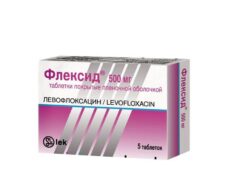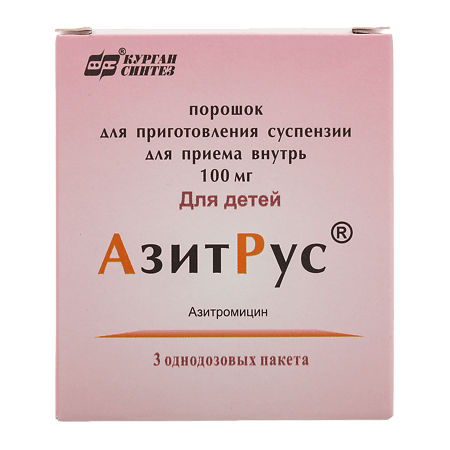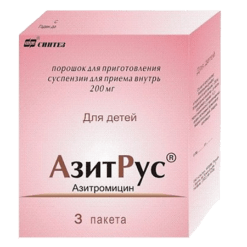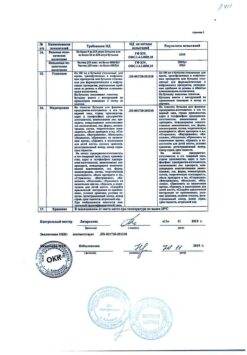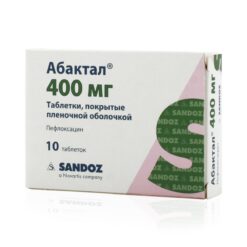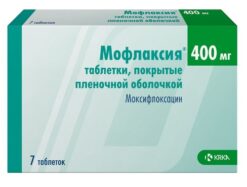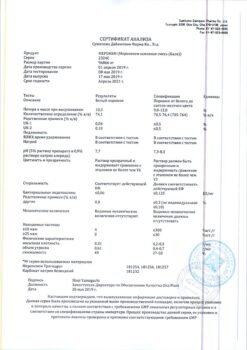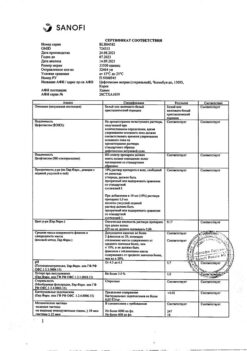Subtotal: €6.41
AzitRus, 50 mg 4.2g 3 pcs.
€1.00
Out of stock
(E-mail when Stock is available)
Skin infections, Otitis media, Infectious diseases, Pharyngitis, Lung inflammation (pneumonia), Urethritis, Haymorrhitis, Angina, Bronchitis, Tonsillitis, Respiratory tract infections
According to the FDA (2020), oral azithromycin is indicated to treat patients with mild to moderate infections (pneumonia: see “Precautions. “Precautions”) caused by susceptible strains of the indicated microorganisms under certain conditions listed below.
Adults
Acute bacterial exacerbations of chronic obstructive pulmonary disease caused by Haemophilus influenzae, Moraxella catarrhalis or Streptococcus pneumoniae.
Acute bacterial sinusitis caused by Haemophilus influenzae, Moraxella catarrhalis or Streptococcus pneumoniae.
Out-of-hospital pneumonia caused by Chlamydophila pneumoniae, Haemophilus influenzae, Mycoplasma pneumoniae or Streptococcus pneumoniae in patients who are prescribed oral therapy.
. Azithromycin should not be used in patients with pneumonia who are not indicated for oral therapy because of moderate to severe disease or when risk factors are present, such as patients with cystic fibrosis, patients with nosocomial infections, patients with known or suspected bacteremia, patients requiring hospitalization, elderly or frail patients, patients with serious underlying health problems that may impede their ability to respond to disease (including immunodeficiency or functional
Pharyngitis/tonsillitis caused by Streptococcus pyogenes is an alternative to first-line therapy in patients in whom first-line therapy cannot be used.
Note. Penicillin administered by injection/m is usually the drug of choice in the treatment of infections caused by Streptococcus pyogenes and the prevention of rheumatic fever. Azithromycin is often effective in eradicating sensitive strains of Streptococcus pyogenes from the nasopharynx. Since some strains are resistant to azithromycin, tests for azithromycin sensitivity should be performed during treatment of patients. There are no data confirming the effectiveness of azithromycin in the subsequent prevention of rheumatic fever.
Uncomplicated infections of the skin and skin structures caused by Staphylococcus aureus, Streptococcus pyogenes or Streptococcus agalactiae. Abscesses usually require surgical intervention.
Urethritis and cervicitis caused by Chlamydia trachomatis or Neisseria gonorrhoeae.
Infectious genital disease in men caused by Haemophilus ducreyi (Chancroid). Because of the small number of women included in clinical trials, the effectiveness of azithromycin in the treatment of chancroid in women has not been established.
Azithromycin should not be relied on at the recommended dose to treat syphilis. Antimicrobials used in high doses for short periods of time to treat nongonococcal urethritis may mask or delay the presentation of symptoms during the incubation period of syphilis. All patients with urethritis or cervicitis as a result of a sexually transmitted infection should have a serologic test for syphilis and appropriate cultures for gonorrhea at the time of diagnosis. If the infection is confirmed, appropriate antimicrobial therapy should be started and follow-up tests for these diseases should be performed.
At the beginning of treatment, appropriate tests should be performed to determine the pathogen and its sensitivity to azithromycin. Azithromycin therapy may be initiated before the results of these tests are available; once the results are available, antimicrobial therapy should be adjusted.
In order to prevent the development of drug-resistant bacteria and to maintain the effectiveness of azithromycin and other antibacterial drugs, azithromycin should only be used to treat or prevent infections for which sensitive bacteria are proven or reasonably suspected to cause them. When culture and sensitivity information is available, it should be considered when selecting or modifying antibiotic therapy. In the absence of such data, the local epidemiologic situation and sensitivity patterns may contribute to the empirical choice of therapy.
Pediatric patients
Acute otitis media caused by Haemophilus influenzae, Moraxella catarrhalis or Streptococcus pneumoniae.
Out-of-hospital pneumonia caused by Chlamydophila pneumoniae, Haemophilus influenzae, Mycoplasma pneumoniae or Streptococcus pneumoniae in patients who are indicated for oral therapy.
. Azithromycin should not be used in pediatric patients with pneumonia who are not indicated for oral therapy because of moderate to severe disease or when risk factors are present, such as patients with cystic fibrosis, patients with hospital-acquired infections, patients with known or suspected bacteremia, patients requiring hospitalization, patients with serious underlying health problems that may impede the ability to respond to disease (including immune deficiency or functional asperity).
Pharyngitis/tonsillitis caused by Streptococcus pyogenes is an alternative to first-line therapy in patients in whom first-line therapy cannot be used.
Note. Penicillin administered by injection/m is usually the drug of choice in the treatment of infections caused by Streptococcus pyogenes and the prevention of rheumatic fever. Azithromycin is often effective in eradicating sensitive strains of Streptococcus pyogenes from the nasopharynx. Since some strains are resistant to azithromycin, tests for azithromycin sensitivity should be performed during treatment of patients. There are no data confirming the efficacy of azithromycin in the subsequent prevention of rheumatic fever.
At the beginning of treatment, appropriate tests should be performed to determine the causative agent and its sensitivity to azithromycin. Azithromycin therapy may be initiated before the results of these tests are available; once the results are available, antimicrobial therapy should be adjusted.
Indications
According to the FDA (2020), oral azithromycin is indicated for the treatment of patients with mild to moderate infections (pneumonia: see Precautions) caused by susceptible strains of these organisms under certain conditions listed below.
Adults
Acute bacterial exacerbations of chronic obstructive pulmonary disease caused by Haemophilus influenzae, Moraxella catarrhalis or Streptococcus pneumoniae.
Acute bacterial sinusitis caused by Haemophilus influenzae, Moraxella catarrhalis or Streptococcus pneumoniae.
Community-acquired pneumonia caused by Chlamydophila pneumoniae, Haemophilus influenzae, Mycoplasma pneumoniae, or Streptococcus pneumoniae in patients prescribed oral therapy.
Azithromycin should not be used in patients with pneumonia who are not candidates for oral therapy because of moderate to severe disease or the presence of risk factors, such as patients with cystic fibrosis, patients with hospital-acquired infections, patients with known or suspected bacteremia, patients requiring hospitalization, elderly or debilitated patients, patients with serious underlying health problems that may interfere with the ability to respond to disease (including immunodeficiency or functional asplenia).
Pharyngitis/tonsillitis due to Streptococcus pyogenes is an alternative to first-line therapy in patients for whom first-line therapy cannot be used.
Note. Penicillin administered intramuscularly is usually the drug of choice for the treatment of infections caused by Streptococcus pyogenes and the prevention of rheumatic fever. Azithromycin is often effective in eradicating susceptible strains of Streptococcus pyogenes from the nasopharynx. Because some strains are resistant to azithromycin, azithromycin susceptibility testing should be performed during treatment of patients. There are no data confirming the effectiveness of azithromycin in the subsequent prevention of rheumatic fever.
Uncomplicated infections of the skin and skin structures caused by Staphylococcus aureus, Streptococcus pyogenes or Streptococcus agalactiae. Abscesses usually require surgery.
Urethritis and cervicitis caused by Chlamydia trachomatis or Neisseria gonorrhoeae.
An infectious disease of the genital organs in men caused by Haemophilus ducreyi (chancroid). Due to the small number of women included in clinical trials, the effectiveness of azithromycin in the treatment of chancroid in women has not been established.
Azithromycin should not be relied upon at the recommended dose to treat syphilis. Antimicrobial agents used in high doses for short periods of time to treat nongonococcal urethritis may mask or delay the onset of symptoms during the incubation period of syphilis. All patients with urethritis or cervicitis due to sexually transmitted infection should undergo serological testing for syphilis and appropriate cultures for gonorrhea at the time of diagnosis. If infection is confirmed, appropriate antimicrobial therapy should be initiated and subsequent testing for these diseases should be performed.
Before starting treatment, appropriate tests should be performed to determine the pathogen and its sensitivity to azithromycin. Azithromycin therapy may be initiated before the results of these tests are known; once results are available, antimicrobial therapy should be adjusted.
To prevent the development of drug-resistant bacteria and maintain the effectiveness of azithromycin and other antibacterial drugs, azithromycin should be used only to treat or prevent infections that are proven or reasonably suspected to be caused by susceptible bacteria. When culture and susceptibility information is available, it should be considered when selecting or changing antibiotic therapy. In the absence of such data, local epidemiology and susceptibility patterns may guide empirical selection of therapy.
Pediatric patients
Acute otitis media caused by Haemophilus influenzae, Moraxella catarrhalis or Streptococcus pneumoniae.
Community-acquired pneumonia caused by Chlamydophila pneumoniae, Haemophilus influenzae, Mycoplasma pneumoniae or Streptococcus pneumoniae in patients for whom oral therapy is indicated.
Azithromycin should not be used in pediatric patients with pneumonia who are not candidates for oral therapy because of moderate to severe disease or the presence of risk factors, such as patients with cystic fibrosis, patients with hospital-acquired infections, patients with known or suspected bacteremia, patients requiring hospitalization, patients with serious underlying health problems that may interfere with the ability to respond to disease (including immunodeficiency or functional asplenia).
Pharyngitis/tonsillitis due to Streptococcus pyogenes is an alternative to first-line therapy in patients for whom first-line therapy cannot be used.
Note. Penicillin administered intramuscularly is usually the drug of choice for the treatment of infections caused by Streptococcus pyogenes and the prevention of rheumatic fever. Azithromycin is often effective in eradicating susceptible strains of Streptococcus pyogenes from the nasopharynx. Because some strains are resistant to azithromycin, azithromycin susceptibility testing should be performed during treatment of patients. There are no data confirming the effectiveness of azithromycin in the subsequent prevention of rheumatic fever.
Before starting treatment, appropriate tests should be performed to determine the pathogen and its sensitivity to azithromycin. Azithromycin therapy may be initiated before the results of these tests are known; once results are available, antimicrobial therapy should be adjusted.
Pharmacological effect
Pharmacology
Active ingredient
Azithromycin
Composition
Active substance:
Pregnancy
Pregnancy
FDA category of effect on the fetus is B.
Teratogenic effects. Reproduction studies have been performed in rats and mice when administered orally at doses up to moderately toxic maternal concentrations (i.e., 200 mg/kg/day). These daily doses for rats and mice, based on body surface area, are estimated to be 4 and 2 times, respectively, the 500 mg daily dose for adults. Animal studies have not found any evidence of harm to the fetus due to the effects of azithromycin. However, adequate and well-controlled studies have not been conducted in pregnant women. Because animal reproduction studies do not always predict effects in humans, azithromycin should be used during pregnancy only when absolutely necessary.
Breastfeeding
Azithromycin has been reported to be excreted in human breast milk in small quantities. Caution should be exercised when using azithromycin in nursing women.
Contraindications
Hypersensitivity to azithromycin, erythromycin, any macrolide or ketolide antibiotics; history of cholestatic jaundice/liver dysfunction associated with previous use of azithromycin.
Side Effects
In clinical trials, most side effects reported were mild to moderate and reversible after discontinuation of azithromycin. Potentially serious side effects such as angioedema and cholestatic jaundice have been rarely reported. Approximately 0.7% of patients (adults and children) participating in the 5-day multiple-dose clinical trials discontinued azithromycin therapy due to treatment-related side effects.
In adults receiving azithromycin 500 mg/day, the discontinuation rate due to treatment-related side effects was 0.6% after 3 days of treatment. In clinical trials in pediatric patients, when 30 mg/kg was administered either as a single dose of azithromycin or for 3 days, discontinuation of azithromycin due to treatment-associated side effects was approximately 1%. Most of the side effects that led to withdrawal were related to the gastrointestinal tract, incl. nausea, vomiting, diarrhea, or abdominal pain.
Clinical trial results
Because clinical trials are conducted under a different set of conditions, the incidence of adverse reactions observed in these clinical trials may not be the same as those obtained in other clinical trials and observed in clinical practice.
Adults
Multi-dose regimens. Overall, the most common treatment-related adverse reactions in adult patients receiving multiple doses of azithromycin were gastrointestinal effects. The most commonly reported adverse reactions were diarrhea/loose stools (4–5%), nausea (3%), and abdominal pain (2–3%).
No other treatment-related adverse events with an incidence greater than 1% were observed in patients receiving multiple doses of azithromycin.
Adverse reactions that occurred with an incidence of ≤1% included the following.
From the cardiovascular system: palpitations, chest pain.
From the gastrointestinal tract: dyspepsia, flatulence, vomiting, melena, cholestatic jaundice.
From the genitourinary system: candidiasis, vaginitis, nephritis.
From the nervous system: dizziness, headache, vertigo, drowsiness.
General: fatigue.
Allergic reactions: rash, skin itching, photosensitivity, angioedema.
Single-dose 1 g regimen: Overall, the most common side effects in patients receiving a single dose of azithromycin 1 g were related to the gastrointestinal system and were reported more frequently than in patients receiving a multiple-dose regimen.
Side effects observed in patients with a single dose of azithromycin with a frequency of 1% or more included diarrhea/loose stools (7%), nausea (5%), abdominal pain (5%), vomiting (2%), dyspepsia (1%), vaginitis (1%).
2 g single dose regimen: Overall, the most common side effects in patients receiving a single 2 g dose of azithromycin were related to the gastrointestinal system.
Side effects observed in patients with a single dose of azithromycin in this study with an incidence of 1% or more included nausea (18%), diarrhea/loose stools (14%), vomiting (7%), abdominal pain (7%), vaginitis (2%), dyspepsia (1%), dizziness (1%). Most complaints were of a moderate nature.
Pediatric patients
Single and multiple dose modes. The types of adverse events in pediatric patients were comparable to those in adults, with varying rates of occurrence for dosing regimens recommended in pediatric practice.
Acute otitis media: At the recommended total dosage of 30 mg/kg, the most common treatment-related adverse effects (≥1%) were diarrhea, abdominal pain, vomiting, nausea, and rash.
The frequency of side effects, depending on the dosage regimen, for 1-, 3- and 5-day dosing regimens was: diarrhea – 4.3; 2.6 and 1.8%; abdominal pain – 1.4; 1.7 and 1.2%; vomiting – 4.9; 2.3 and 1.1%; nausea – 1, 0.4 and 0.5%; rash – 1, 0.6 and 0.4%.
Community-Acquired Pneumonia: For the recommended dosage regimen of 10 mg/kg on day 1 followed by 5 mg/kg on days 2–5, the most common treatment-related adverse events were diarrhea/loose stools (5.8%), abdominal pain (1.9%), vomiting (1.9%), nausea (1.9%), and rash (1.6%).
Pharyngitis/tonsillitis: At the recommended dosing regimen of 12 mg/kg on days 1–5, the most common treatment-related adverse events were diarrhea (5.4%), abdominal pain (3.4%), vomiting (5.6%), nausea (1.8%), rash (0.7%), headache (1.1%).
No other treatment-related adverse events occurring with an incidence of >1% were observed in pediatric practice with any treatment regimen.
Side effects observed with an incidence of ≤1% included the following.
From the cardiovascular system: chest pain.
From the gastrointestinal tract: dyspepsia, constipation, anorexia, enteritis, flatulence, gastritis, jaundice, loose stools, oral candidiasis.
From the blood and lymphatic system: anemia, leukopenia.
From the nervous system: headache (with otitis media), hyperkinesia, dizziness, agitation, nervousness, insomnia.
General: fever, facial swelling, fatigue, fungal infection, malaise, pain.
Allergic: rash and allergic reaction.
From the respiratory system: increased cough, pharyngitis, pleural effusion, rhinitis.
From the skin and its appendages: eczema, fungal dermatitis, itching, sweating, urticaria, vesiculobullous rash.
From the senses: conjunctivitis.
Post-marketing experience
Adverse reactions reported during post-marketing experience with azithromycin in adults and/or pediatric patients for which a causal relationship has not been established include the following.
Allergic reactions: arthralgia, edema, urticaria and angioedema.
From the cardiovascular system: arrhythmia, including ventricular tachycardia and hypotension. There have been case reports of QT prolongation and torsade de pointes.
From the gastrointestinal tract: anorexia, constipation, dyspepsia, flatulence, vomiting/diarrhea, rarely leading to dehydration, pseudomembranous colitis, pancreatitis, oral candidiasis, pyloric stenosis, there are rare reports of changes in the color of the tongue.
Common: asthenia, paresthesia, fatigue, malaise and anaphylaxis (rarely fatal).
From the genitourinary system: interstitial nephritis, acute renal failure and vaginitis.
From the side of hematopoiesis: thrombocytopenia.
From the liver/biliary tract: adverse reactions associated with liver dysfunction.
From the nervous system: convulsions, dizziness/vertigo, headache, drowsiness, hyperactivity, nervousness, agitation and fainting.
Mental disorders: aggressive reaction and anxiety.
From the skin and its appendages: itching, serious skin reactions, including erythema multiforme, Stevens-Johnson syndrome, toxic epidermal necrolysis and DRESS syndrome.
Senses: Hearing disturbances, including hearing loss, deafness and/or tinnitus, and reports of distortion and/or loss of taste/smell.
Laboratory abnormalities
Adults
Clinically significant abnormalities (irrespective of drug-related) were reported during clinical trials with a frequency of more than 1%: decrease in Hb, hematocrit, lymphocytes, neutrophils and blood glucose, increase in serum CPK, potassium, ALT, GGT, AST, bilirubin, creatinine, blood glucose, platelet count, lymphocytes, neutrophils and eosinophils; with a frequency of less than 1%: leukopenia, neutropenia, decrease in sodium, potassium, platelet count, increase in the number of monocytes, basophils, bicarbonate, serum alkaline phosphate, bilirubin, LDH and phosphates. Most patients with elevated serum creatinine also had abnormal baseline values.
Changes in laboratory tests were reversible.
In multiple-dose clinical trials involving more than 5000 patients, 4 patients discontinued azithromycin therapy due to treatment-related liver enzyme abnormalities and 1 due to renal dysfunction.
Pediatric patients
One-, three- and five-day regimens. Laboratory data collected during comparative clinical trials using two 3-day regimens (30 or 60 mg/kg in divided doses for 3 days) or two 5-day regimens (30 or 60 mg/kg) in divided doses for 5 days) were similar for all azithromycin dosing regimens, with the most clinically significant laboratory abnormalities occurring in frequency 1–5%.
Laboratory data for patients receiving 30 mg/kg as a single dose were collected in a single-center study. In this trial, absolute neutrophil counts between 500 and 1500 cells/mm3 were observed in 10 of 64 patients receiving 30 mg/kg as a single dose, 9 of 62 patients receiving 30 mg/kg for 3 days, and 8 of 63 control patients. No patient had an absolute neutrophil count <500 cells/mm3.
In a multiple-dose clinical trial involving approximately 4,700 pediatric patients, no patients had therapy discontinued due to treatment-related laboratory abnormalities.
Interaction
With simultaneous use of antacids (aluminum- and magnesium-containing), ethanol and food slow down and reduce the absorption of azithromycin.
When azithromycin was used together in therapeutic doses with warfarin, no changes in prothrombin time were observed, however, given that the interaction of macrolides with warfarin may enhance the anticoagulant effect, when prescribing this combination to patients, careful monitoring of prothrombin time is necessary.
With simultaneous use, the concentration of digoxin in the blood plasma increases.
With simultaneous use, the toxic effect (vasospasm, dysesthesia) of ergotamine and dihydroergotamine increases.
With simultaneous use, clearance decreases and the pharmacological effect of triazolam increases.
Azithromycin inhibits microsomal oxidation in hepatocytes, which leads to a slower elimination and increased plasma concentrations and toxicity of cycloserine, indirect anticoagulants, methylprednisolone, felodipine, as well as drugs subject to microsomal oxidation (carbamazepine, terfenadine, cyclosporine, hexobarbital, ergot alkaloids, valproic acid, disopyramide, bromocriptine, phenytoin, oral hypoglycemic agents, xanthine derivatives, including theophylline).
Lincosamines reduce the effectiveness of azithromycin.
Tetracycline and chloramphenicol enhance the effectiveness of azithromycin.
Special instructions
The drug should not be taken with meals.
If a dose is missed, the missed dose should be taken as soon as possible, and subsequent doses should be taken at intervals of 24 hours.
It is necessary to observe a break of at least 2 hours between doses of the drug AzitRus® and antacid drugs.
After discontinuation of the drug, hypersensitivity reactions may persist in some patients; in such cases, it is recommended to prescribe specific therapy under medical supervision.
Overdose
Symptoms: nausea, temporary hearing loss, vomiting, diarrhea.
Treatment: gastric lavage, symptomatic therapy.
Storage conditions
In a dry place, protected from light, at a temperature of 15–25 °C.
Shelf life
2 years
Manufacturer
Sintez, Russia
| Shelf life | 2 years |
|---|---|
| Conditions of storage | In a dry, light-protected place at 15-25 °C. |
| Manufacturer | Sintez OAO, Russia |
| Medication form | Powder for oral suspension |
| Brand | Sintez OAO |
Other forms…
Related products
Buy AzitRus, 50 mg 4.2g 3 pcs. with delivery to USA, UK, Europe and over 120 other countries.

